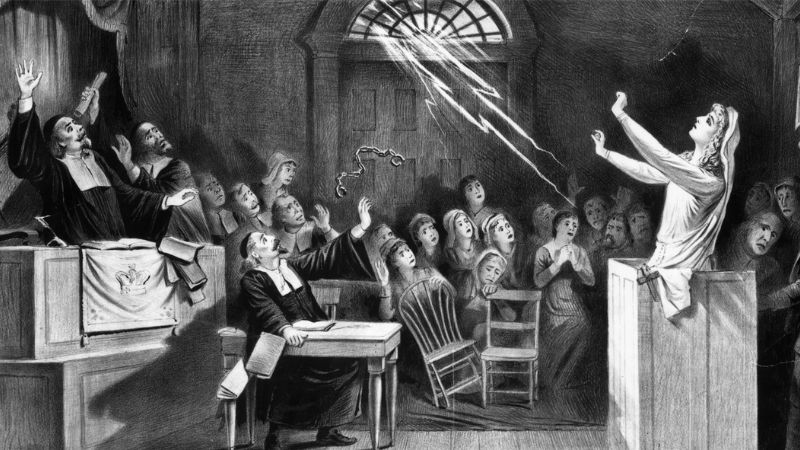The British Empire had a “civilizing mission” and a moral reform justification as they extended their brutal colonial grip on India. As part of their “civilisation crusade”, they prohibited sati pratha in 1829 with the backing of “reformer” Raja Rammohun Roy.
It is this legislation that uncovers complex layers of hypocrisy and cultural blindness. While colonial authorities imposed moral standards on Indian practices, the record of their own history was tainted by the brutal witch trials and executions of thousands of women under the stigma of – sorceresses.
Witch Trials in England
In Saxon times witchcraft was characterized more as a pagan custom; between the 16th and 17th centuries, England endured a frenzy of witch trials, where thousands of individuals, mostly women, were accused of practicing dark magic. The first laws regarding witchcraft were laid in England by Henry VIII in 1542, who characterized witchcraft as a capital crime and set the stage for prosecuting alleged witches. The reinstatement of these laws by Elizabeth I in 1562 created a fertile ground for paranoia to run rampant across the country, paving the way for opportunists to accuse their neighbours and unanswered brutality against those accused.
The Pendle Witch Trials of 1612 epitomise this brutal age, where accused women were imprisoned under terrible conditions at Lancaster Castle, and were tortured, and hanged.
Under the reign of King James I, the paranoia regarding witchcraft grew beyond bounds. Consequently, accusations became rampant. The North Berwick Witch Trials in Scotland were the result of extreme paranoia after James experienced a storm at sea which he attributed to witches. This deep-seated belief resulted in James further criminalizing witchcraft when he acceded the English throne in 1603, creating a culture of fear and mistrust in the English society.
The “Witchfinder General” and the Atrocities of Matthew Hopkins
This period also saw the rise of self-claimed “witch hunters” such as Matthew Hopkins who targeted villages and communities with his ruthless methods. Some of them included a needle test that was supposed to reveal the “Devil’s Marks” on followers of satan. Many innocents were hanged based on flimsy evidence, with Hopkins profiting from towns eager to rid themselves of alleged witches. The most infamous one was, ‘the swimming’ where suspected witches were thrown into the water, if she floated she was indeed a witch. Mostly, they were hanged as punishment.
The hysteria culminated in mass trials, like those in Chelmsford, where, in a single day, nineteen supposed witches were sentenced to death. England’s marketplaces and town squares became execution sites, leaving behind a legacy of fear and injustice. Though England’s witchcraft laws were repealed in 1736, the scars of these trials remained.
Sati in India: A Tradition Misrepresented
Faced with this veil of cruelty, the British set their sights on `reforming’ the Indian society by focusing on Sati – a custom with roots far less rigid and widespread than British propaganda suggested.
While Sati had existed in India —often intended as a spiritual choice by a widow to join her deceased husband—the British depicted it as an evil emblematic of Hindu society., the British viewed this as a barbaric act that mistreated women. Symbolic of a barbarous practice that Britain so detested, this act existed in texts such as the Ramayana and the Mahabharata but more as an optional practice that was occasionally overused by women such as Kunti declines, while Madri chooses it.
But the “educated” British and Indian contemporaneous society hoped for a positive change. Pick-me-reformers as Raja Rammohun Roy, who sought to impose Western culture on Hindus, portrayed sati as an act of savagery, such that the British Empire should intervene and “save” Indian society. He pushed not only British values but also admired British customs. Roy made used of the opportunities given by Christian missionaries to speak openly against sati, gaining support from britons who targeted the practice. Roy and the British forgot about the dark history of lynching women in England, the less horrific practice they were condemned in India.
British intervention aimed at the regulation of sati revealed a morally and Anglicised superiority. In Europe approximately 80,000 females were held guilty of witchcraft and were either executed, hanged or burned. Unlike sati that was almost exclusively carried out as an act of devotion, witch trial were done to cause harm and carry out vendetta against one’s enemy. However the British interpretation saw Sati as a symbol of Hindu brutality and as a means by which colonialism could be presented as an act of cultural rectification.
While one could debate their intentions, it is highly improbable that the British actions were motivated by a concern for Indian interests rather than their own. The 1829 sati ban stands out as a rare example of British intervention in local customs, where moral reform was prioritized over political appeasement. However, following the 1857 Indian Rebellion, colonial authorities adjusted their approach to sati cases, seeking to gain the support of conservative Hindu factions that had played a significant role in the uprising. By 1862, the British had downgraded the punishment for sati abetment from murder to “abetment of suicide”. One can argue that British commercial interests always prevailed over morality.
